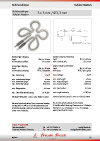Service
Because oft he hygroscopic characteristic of the used ceramic insulation materials they absorb moisture.When stored unprotected in environmental air it is absolutely important to check the insulation resistance before use and – if necessary – to dry the elements (controlled start-up or drying oven).
Our heating elements are designed for being operated at defined voltages. Operation at higher voltages may reduce lifetime considerably or result in immediate failure (15% more voltage = 32% more power!).
A too slag fit obstructs the heat conduction and leads to heat accumulation that could overheat and eventually destroy the heater.
The termination area must be protected from lubricants, detergents and solvents as these could diffuse into the tubular heater and lead to short circuits.
For flexible tubular heaters: elements which are bent once, should not be altered anymore. The connection area as well as the first 5 mm must not be deformed at all.
Surface density must be chosen in relation to the material to be heated. If the surface density is too high, the material to be heated could be destroyed.
When used in aggressive media, please pay attention to using of correspondigly resistant material of the tubular heater.
In every practice application there are working and environmental parameters which cannot be calculated exactly in theory. That is why we recommed generally to test our heating elements in the application under real working conditions before series use.
No warranty claims can be derived from these user instructions.
Downloads:
-
Flyer Tubular Heaters 3 x 3 mm / Ø 3,3 mm

Download our leaflet to our tubular heaters with the dimensions 3 x 3 mm / Ø 3,3 mm
-
Really hot! Our Product Flyer.

Download our leaflet here.
